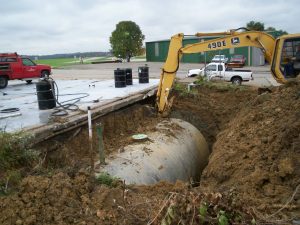 In 2012 a Houston area college purchased a plot of land for a parking lot. Part of the financing requirements included an Environmental Site Assessment (ESA). During the ESA, Phase I, it was determined that there was an abandoned gas station on the premises. The underground storage tanks needed to removed and the groundwater and soil tested for contamination (Phase II ESA). Contamination was found in both and a Phase III Remediation Plan was developed and carried out. Part of the plan was to monitor the site until groundwater levels were below the parameters set by the Texas Commission on Environmental Quality (TCEQ), which took over ten years. How was it done?
In 2012 a Houston area college purchased a plot of land for a parking lot. Part of the financing requirements included an Environmental Site Assessment (ESA). During the ESA, Phase I, it was determined that there was an abandoned gas station on the premises. The underground storage tanks needed to removed and the groundwater and soil tested for contamination (Phase II ESA). Contamination was found in both and a Phase III Remediation Plan was developed and carried out. Part of the plan was to monitor the site until groundwater levels were below the parameters set by the Texas Commission on Environmental Quality (TCEQ), which took over ten years. How was it done?
A total of ten (10) permanent monitoring wells were installed throughout the site and across the street, as determined by the testing and plan to delineate the groundwater both vertically and horizontally. The monitoring wells were then sampled quarterly for over ten years.
 After monitoring wells installation, all were gauged with an oil/water separator to determine the static depth to the groundwater, groundwater flow direction, and any presence of gasoline or diesel (non-aqueous phase liquids (NAPLs)). Then the monitoring wells were sampled by using the low-flow method sampling technique. A groundwater pump was used to remove the groundwater. A water quality meter with a flow-through cell was used to monitor the groundwater chemistry. When the groundwater chemistry was stable enough for each monitoring well (approximately 45 minutes) the groundwater samples were collected.
After monitoring wells installation, all were gauged with an oil/water separator to determine the static depth to the groundwater, groundwater flow direction, and any presence of gasoline or diesel (non-aqueous phase liquids (NAPLs)). Then the monitoring wells were sampled by using the low-flow method sampling technique. A groundwater pump was used to remove the groundwater. A water quality meter with a flow-through cell was used to monitor the groundwater chemistry. When the groundwater chemistry was stable enough for each monitoring well (approximately 45 minutes) the groundwater samples were collected.
The soil and groundwater samples were collected and analyzed for total petroleum hydrocarbons (TPH) by TX Method 1005 and Benzene, Toluene, Ethyl Benzene, and Xylene -Methyl Tertiary Butyl Ether (BTEX-MTBE) by EPA method 8260. Additionally, one groundwater sample (exhibiting the highest concentrations of TPH above C6-C12) was collected and analyzed for Poly-Aromatic Hydrocarbons (PAHs) by EPA Method 8270C. The excess soil and groundwater were placed into steel 55-gallon drums and properly disposed of at a landfill.
All the samples were submitted to an independent laboratory that participated in the TCEQ Texas Laboratory Accreditation Program (TLAP) and that was accredited with the National Environmental Laboratory Accreditation Conference (NELAC) standard for matrices, methods, and parameters of analysis. Chain-of-custody documentation was maintained from the field through the laboratory analyses. All the samples were delivered to the lab within 48-hours of collection and maintained on ice below 5C throughout the process.
In 2019, ERC took over the site and removed an area of soil around the original tank hold that contained the most contamination or source, approximately 350 cubic yards. Then ERC sampled the monitoring wells and worked with the college to provide the necessary documentation to close out the project with the TCEQ. The most recent sampling indicated full remediation has been completed and soil and groundwater samples are within the parameters set by the TCEQ, since the source was removed, and the concentrations of the groundwater contamination have been continually going down.
If you have a underground storage tank project, let ERC quote for removal, remediation, and, if applicable, replacement. Contact us today!
